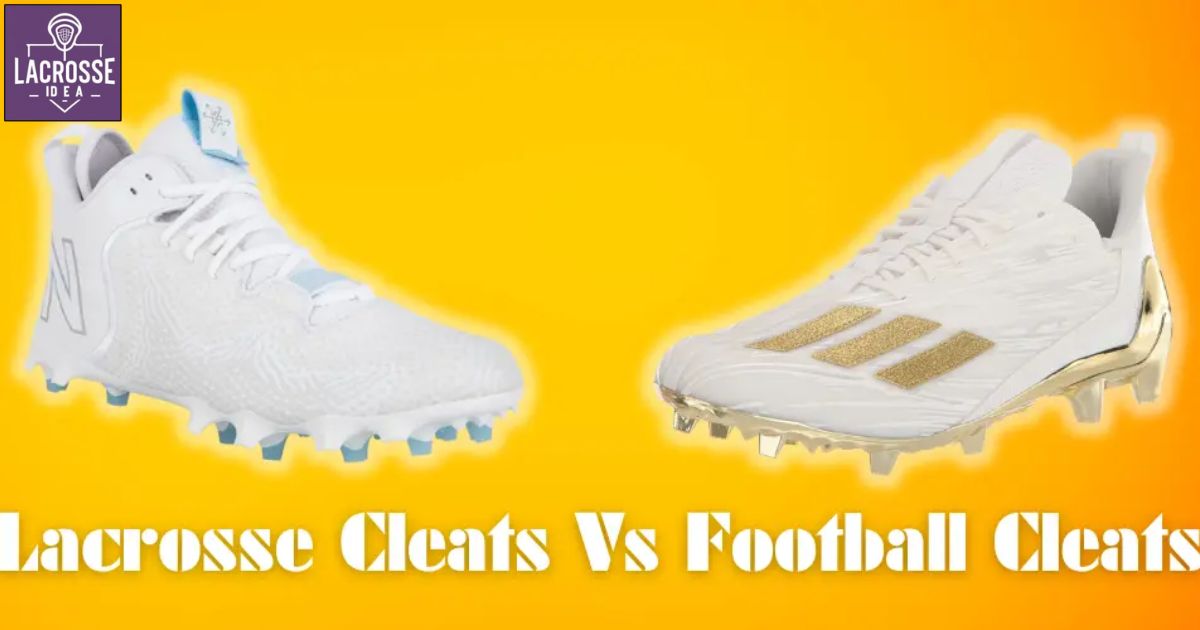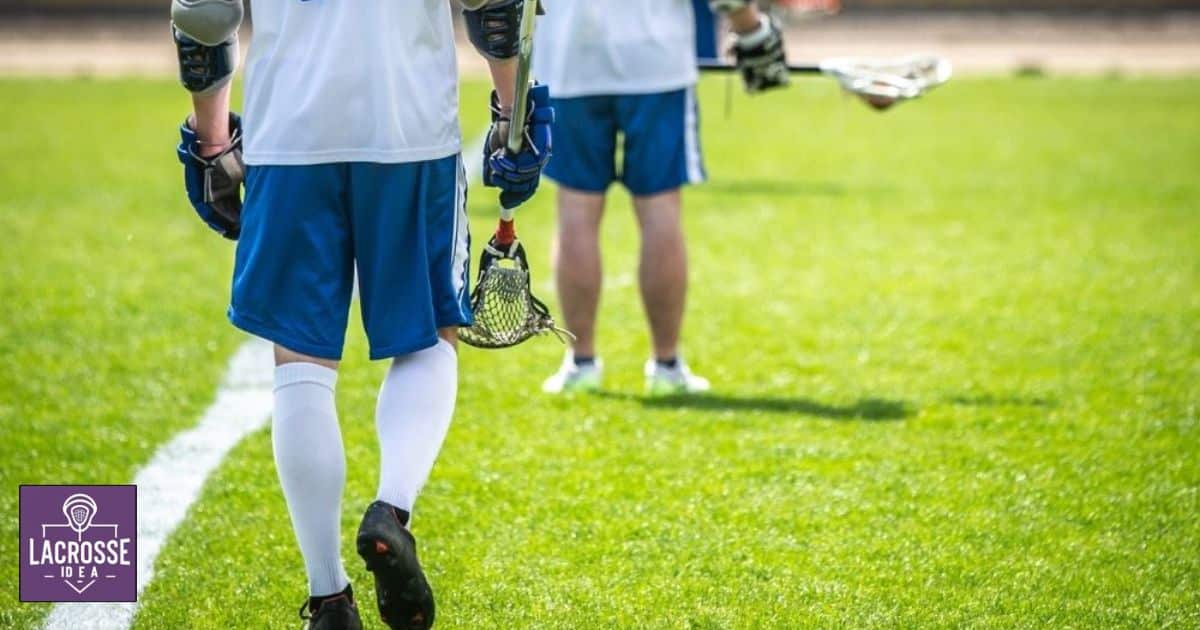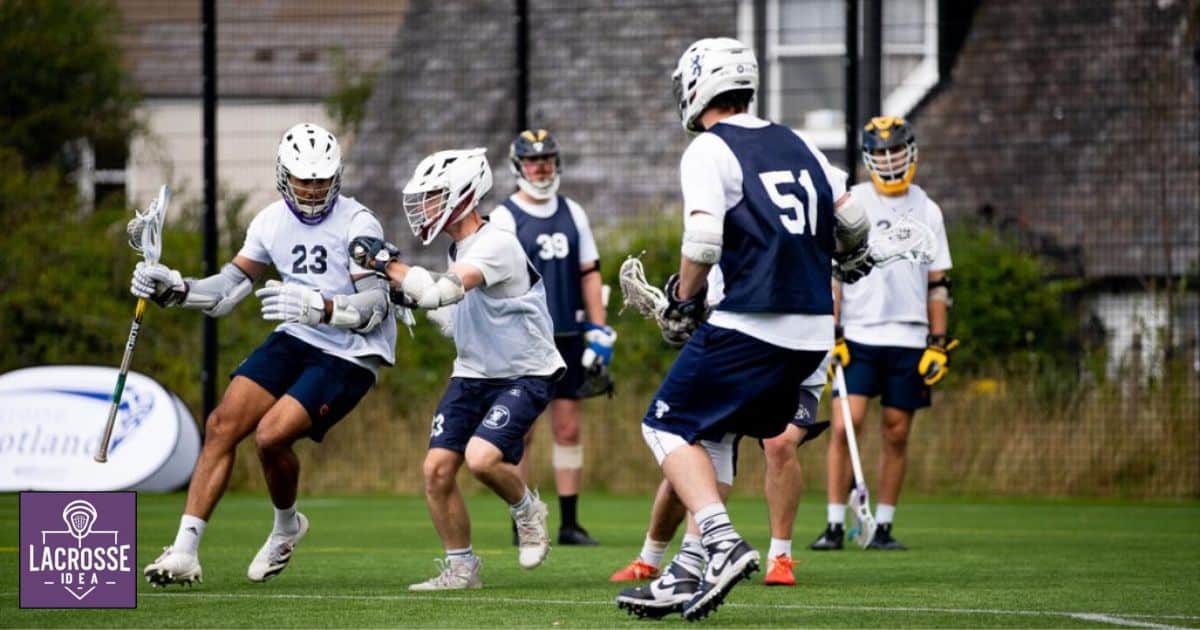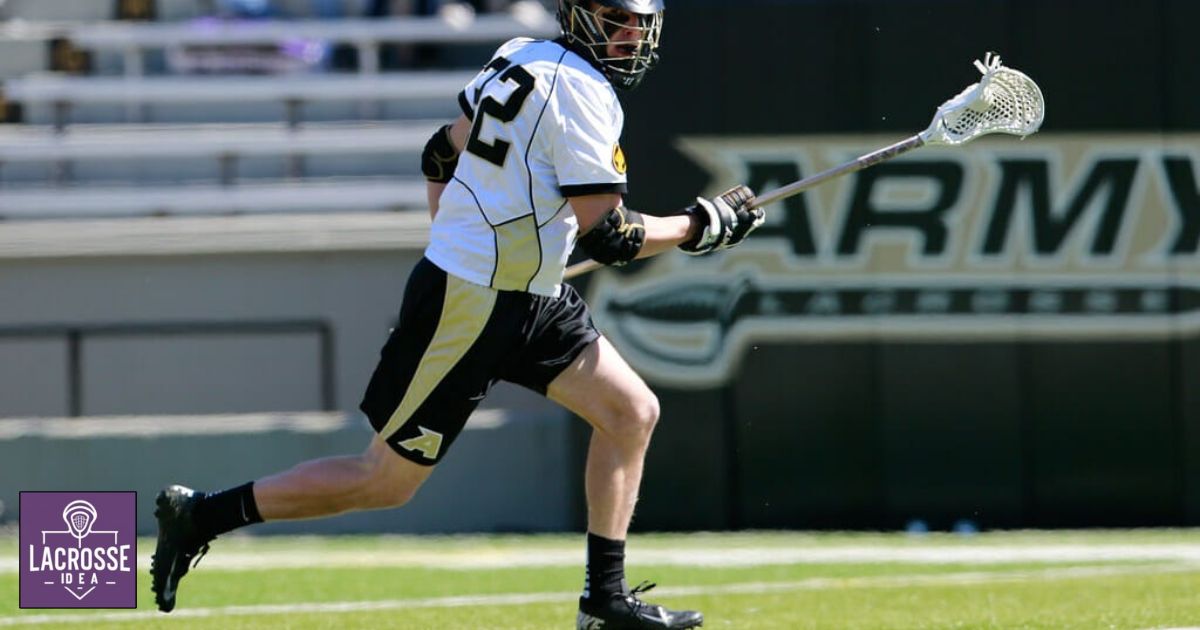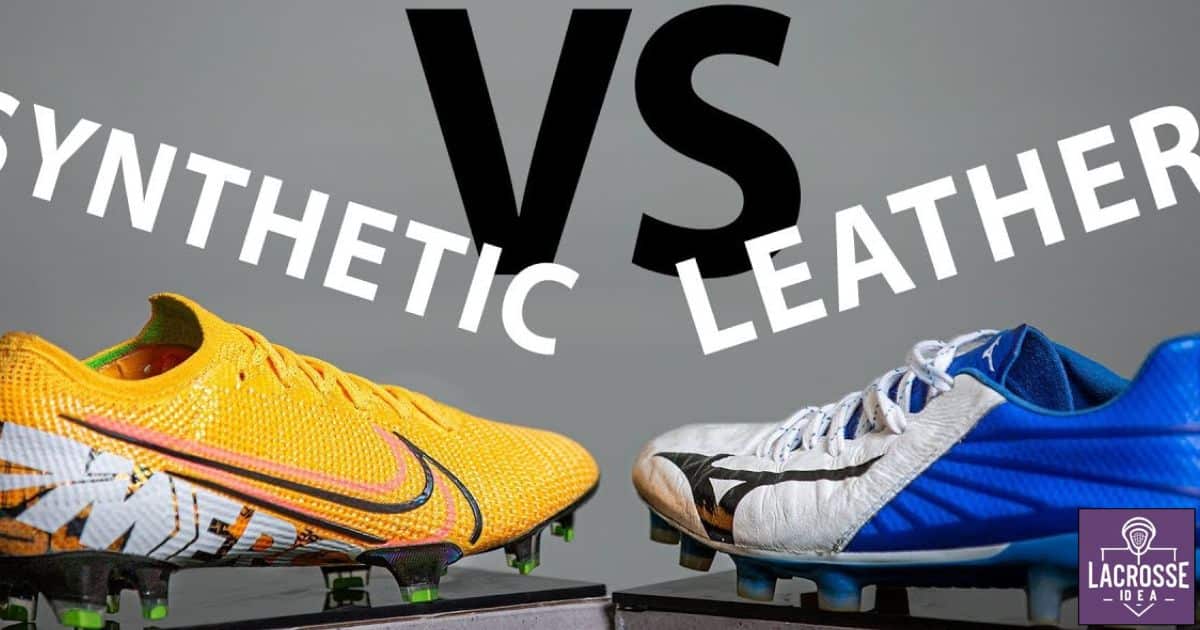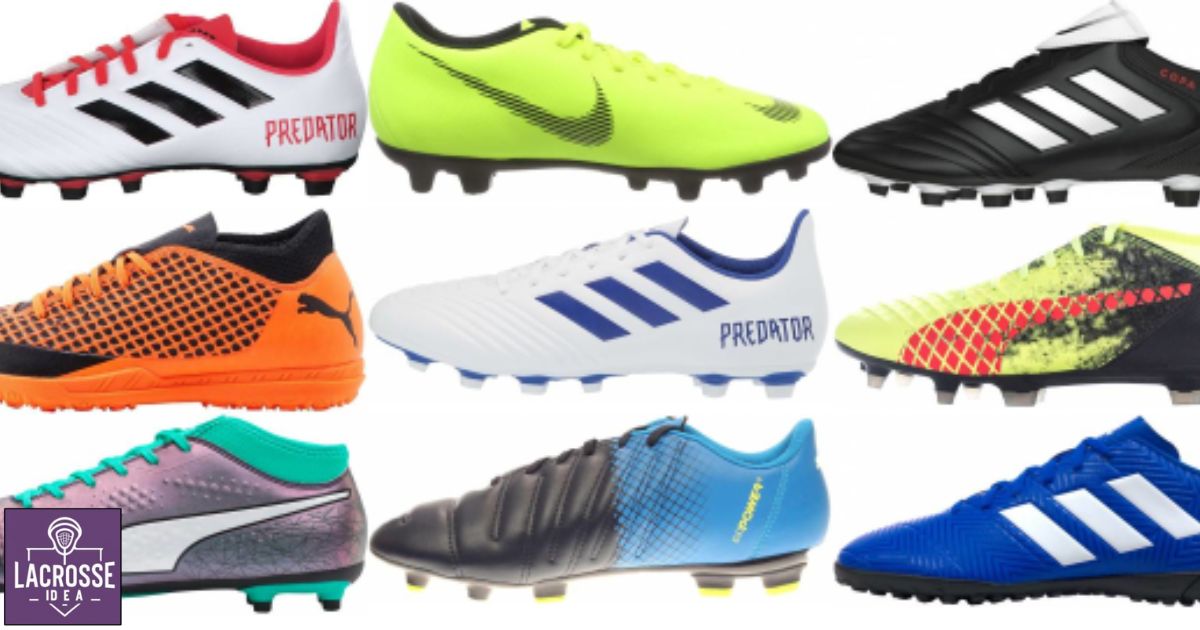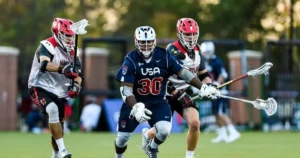Are football and lacrosse cleats the same? When it comes to equipping yourself properly for the game, the significance of the right footwear cannot be underestimated. In this article, we will explore the key differences in cleat design, traction requirements, and specialized features for both football and lacrosse players. By understanding these nuances, you can make an informed decision when choosing the right cleat for your sport. So, let’s dive in and discover the factors that set these cleats apart and ensure you feel a sense of belonging on the field.
Key Takeaways
- Football cleats have more studs for better traction on grass or turf fields, while lacrosse cleats have fewer studs for maneuverability on various surfaces.
- Football cleats have a higher ankle cut for support and stability, while lacrosse cleats allow for greater mobility and agility.
- Football cleats have a thicker midsole and more cushioning, while lacrosse cleats may have aggressive traction patterns for quick movements in all directions.
- The choice between studs and blades depends on personal preference and playing conditions, with studs providing better traction on soft and muddy surfaces and blades offering better grip on artificial turf and firm ground.
The Importance of Proper Footwear
The importance of proper footwear cannot be underestimated in both football and lacrosse. Whether you’re sprinting down the field or making quick cuts, having the right shoes can significantly impact your performance and reduce the risk of injury. One crucial aspect of proper footwear is traction technology. Cleats with advanced traction systems provide athletes with better stability and grip on the field, allowing them to make quick turns and sudden stops without slipping.
Another essential factor is proper sizing. Ill-fitting shoes can cause discomfort, blisters, and even foot injuries. It is crucial to choose cleats that fit snugly but not too tight, providing enough support and allowing for natural foot movement. By investing in high-quality footwear with the right traction technology and proper sizing, athletes can enhance their performance and feel confident on the field.
Key Differences in Cleat Design
When comparing football and lacrosse cleats, it is important to note the key differences in their respective cleat designs. The evolution of cleat design has had a significant impact on player safety in both sports. Here are the key differences:
- Football cleats often have a larger number of studs or spikes to provide better traction on grass or turf fields, while lacrosse cleats typically have fewer studs for better maneuverability on various surfaces.
- Football cleats have a higher ankle cut to provide more support and stability, while lacrosse cleats have a lower cut to allow for more flexibility and agility.
- Football cleats often have a thicker midsole and more cushioning to absorb the impact of tackles, while lacrosse cleats prioritize lightweight construction for speed and quick movements.
- Football cleats may feature additional protective elements, such as reinforced toe caps or ankle padding, to enhance player safety during physical contact, which are not typically found in lacrosse cleats.
Traction Requirements for Football Players
Football players require a high level of traction for optimal performance on the field. Proper fitting and cleat customization are essential to ensure players have the necessary grip and stability to maneuver quickly and change direction with ease. The right traction can make a significant difference in a player’s ability to accelerate, decelerate, and maintain balance during intense gameplay.
To understand the specific traction requirements for football players, let’s take a look at the following table:
| Surface Type | Traction Requirement | Recommended Cleat Type |
|---|---|---|
| Grass | Moderate | Molded or Detachable |
| Turf | High | Turf shoes |
| Artificial Grass | Moderate to High | Turf shoes or AG cleats |
| Wet Conditions | High | Detachable Cleats |
| Indoor | Moderate | Indoor soccer shoes |
As we can see, different playing surfaces demand varying levels of traction. It is crucial for football players to select the appropriate cleats that offer the necessary grip for their specific field conditions. Now, let’s move on to discussing the traction requirements for lacrosse players.
Traction Requirements for Lacrosse Players
Lacrosse players also have specific traction requirements that are crucial for their performance on the field. To ensure optimal traction, lacrosse players employ various techniques and strategies. These include:
- Cleat selection: Lacrosse players need cleats with aggressive traction patterns that allow for quick movements in all directions.
- Stud length customization: Adjusting the length of the studs can help players adapt to different field conditions, such as wet or dry surfaces.
- Cleat customization: Some players customize their cleats by adding additional studs or traction elements to enhance grip and stability.
- Field maintenance: Proper field maintenance, including regular mowing and leveling, ensures a consistent playing surface that facilitates traction.
Studs Vs. Blades: Which Is Better
When it comes to choosing between studs and blades, one must consider the performance on different terrains. Studs are typically better for softer surfaces such as grass or mud, providing superior traction and stability. On the other hand, blades are more suitable for artificial turf or harder ground, offering increased maneuverability and speed. Ultimately, the choice between studs and blades depends on the specific playing conditions and the player’s personal preference.
Studs or Blades
There is a debate among athletes and sports enthusiasts about the superiority of studs or blades in cleats. Both studs and blades have their own advantages and disadvantages, and the choice ultimately depends on personal preference and the type of sport being played. Here are some key points to consider when comparing studs vs. blades and their impact on player performance:
- Studs:
- Provide better traction on soft and muddy surfaces.
- Allow for quick changes in direction and acceleration.
- Can dig into the ground for stability.
- May cause more pressure points and discomfort on hard surfaces.
- Blades:
- Offer better grip on artificial turf and firm ground.
- Provide smoother and more consistent movement.
- Reduce the risk of ankle injuries.
- May not penetrate as deeply into the ground, resulting in less stability.
Considering the performance on different terrains, let’s explore how studs and blades fare in various playing conditions.
Performance on Different Terrains
Football and lacrosse cleats’ performance on different terrains can be compared by analyzing the effectiveness of studs and blades. When it comes to traction on artificial turf, both studs and blades have their advantages. Studs, with their longer and sharper spikes, provide excellent grip on artificial turf, allowing players to make quick movements without slipping.
On the other hand, blades, with their shorter and wider design, offer more stability and control on these surfaces. However, when it comes to performance on wet surfaces, studs have the upper hand. The longer spikes of studs provide better traction and prevent slipping, whereas blades may not have the same level of grip. As we explore the topic of performance on different terrains, it is essential to consider not only traction but also ankle support and stability, which we will discuss in the next section.
Ankle Support and Stability
When it comes to ankle support and stability, the design of cleats plays a crucial role in determining the impact on player performance. Football cleats are typically designed with higher ankle support to provide stability and prevent injuries during quick directional changes and tackles.
On the other hand, lacrosse cleats often have lower ankle support to allow for greater flexibility and agility required in the sport. These differences in cleat design can have a significant impact on the overall performance and safety of players in both football and lacrosse.
Cleat Design Differences
Cleat design in football and lacrosse differs significantly in terms of ankle support and stability. The evolution of cleat design in both sports has had a significant impact on injury prevention. Here are some key differences in cleat design between football and lacrosse:
- Football cleats often feature a higher cut design that provides better ankle support, as football players are more prone to ankle injuries due to the nature of the sport.
- Lacrosse cleats typically have a lower cut design, allowing for greater mobility and agility on the field.
- Football cleats may have additional ankle straps or reinforcements to enhance stability and reduce the risk of sprains.
- Lacrosse cleats prioritize flexibility and lightweight construction to facilitate quick movements and rapid changes in direction.
Understanding these differences in cleat design is crucial to selecting the right footwear for each sport, as it directly impacts player performance and safety. Now let’s move on to exploring the impact of cleat design on player performance.
Impact on Player Performance
The difference in cleat design between football and lacrosse has a significant impact on player performance, particularly in terms of ankle support and stability. Traction performance plays a crucial role in both sports, with football requiring quick changes in direction and lacrosse demanding agility on various surfaces. Football cleats typically have a higher cut, providing more ankle support and stability. This design helps protect the player from sprains and other ankle injuries that are common in the sport.
On the other hand, lacrosse cleats have a lower cut, allowing for greater mobility and agility. However, shoe technology advancements have led to the development of specialized lacrosse cleats that incorporate elements of football cleats, such as enhanced ankle support, without compromising performance. These advancements have revolutionized the industry, allowing athletes to maximize their potential in both sports while minimizing the risk of injury.
Cleat Durability and Longevity
Football and lacrosse cleats display varying levels of durability and longevity. The durability and longevity of a cleat are important factors to consider when choosing the right footwear for these sports. Here are some key points to note:
- Cleat maintenance tips: Proper maintenance can significantly extend the lifespan of your cleats. Regularly cleaning them and storing them in a dry place can help prevent wear and tear.
- Impact of cleat quality on player performance: High-quality cleats are designed to withstand the demands of intense gameplay. They provide better support, traction, and stability, which can enhance a player’s performance on the field.
- Different playing surfaces: Football and lacrosse are played on different surfaces, such as grass, turf, or artificial turf. The type of surface can affect the wear and tear on cleats, with artificial turf being particularly harsh on footwear.
- Brand reputation: Some brands are known for producing durable and long-lasting cleats. Researching reputable brands can help you make a more informed decision when purchasing cleats.
It is crucial to invest in cleats that offer both durability and longevity to ensure optimal performance and to avoid frequent replacements.
Comfort and Fit for Optimal Performance
When considering the performance of athletes in football and lacrosse, it is important to examine the role that comfort and fit play in their optimal performance. Both sports require cleats that provide adequate traction and ankle support to prevent injuries and enhance performance on the field. Comfortable and well-fitting cleats allow athletes to move with confidence, agility, and stability, enabling them to make quick turns, cuts, and pivots without the fear of slipping or losing balance.
In football, where players often engage in intense physical contact, the right cleats can provide the necessary ankle support to prevent sprains and other injuries. Similarly, in lacrosse, where quick movements and changes in direction are crucial, cleats with proper ankle support can enhance performance and reduce the risk of ankle injuries. As we explore the importance of comfort and fit, it is essential to also consider the impact of cleat weight and agility on the field.
Cleat Weight and Agility on the Field
In both football and lacrosse, the weight and agility of cleats significantly impact an athlete’s performance on the field. When it comes to cleat weight, lighter cleats offer several advantages. They enable faster acceleration and deceleration, allowing players to react quickly to changing game situations. Lighter cleats also reduce fatigue, enabling athletes to maintain their speed and agility for longer periods. Additionally, they provide a better feel for the ground, improving balance and stability.
On the other hand, agility improvement is crucial for both sports. Cleats with better agility features, such as enhanced traction patterns and flexible soles, allow players to make quick cuts, change direction effortlessly, and maintain their balance during rapid movements. Overall, finding cleats with the right weight and agility features is essential for maximizing performance on the football or lacrosse field.
Cleat Materials: Synthetic Vs. Leather
When it comes to choosing between synthetic and leather cleats, durability and performance in different terrains are key factors to consider. Synthetic cleats are typically more durable and resistant to wear and tear, making them a popular choice for players who frequently play on rough or artificial surfaces.
On the other hand, leather cleats offer a superior feel and touch on the ball, making them a preferred option for players who prioritize precision and control. Ultimately, the choice between synthetic and leather cleats depends on individual preferences and playing conditions.
Synthetic Vs. Leather Durability
The durability of synthetic and leather cleat materials has been a subject of debate among football and lacrosse players alike. When comparing the performance and durability of leather and synthetic cleats, there are a few key factors to consider:
- Leather:
- Known for its natural flexibility and moldability to the foot
- Offers excellent breathability, allowing for better airflow and moisture control
- Can withstand rough playing conditions and heavy use
- Requires regular maintenance and conditioning to maintain its durability
- Synthetic:
- Provides enhanced durability and resistance to wear and tear
- Offers a lighter weight option, which can improve speed and agility on the field
- Requires less maintenance and is often easier to clean
- May lack the same level of comfort and breathability as leather
Ultimately, the choice between leather and synthetic cleats depends on individual preference and playing style. It is important to consider the specific needs of the sport and personal comfort when making a decision.
Performance in Different Terrains
Cleat materials, whether synthetic or leather, perform differently in various terrains based on their specific properties and characteristics. The choice of cleat material can have a significant impact on player performance on different terrains. Synthetic materials offer several advantages, such as being lightweight, durable, and water-resistant. These properties make synthetic cleats suitable for playing on artificial turf, where the surface is often harder and less forgiving.
On the other hand, leather cleats provide a more natural and responsive feel, allowing for better traction and control on grass or natural surfaces. Leather cleats tend to mold to the shape of the player’s foot over time, providing a custom fit and enhanced comfort. Ultimately, the decision between synthetic and leather cleats depends on the specific playing conditions and personal preferences of the player.
Specialized Features for Each Sport
Each sport requires specialized features in their respective cleats. When it comes to football and lacrosse cleats, there are specific characteristics that cater to the unique needs of each sport. Here are some of the key differences in specialized features:
- Traction differences: Football cleats typically have longer and thicker studs to provide stability and traction on grassy fields, while lacrosse cleats have shorter studs for quick movements on a variety of surfaces.
- Impact on player performance: Football cleats often have additional padding and ankle support to protect players from high-impact collisions, whereas lacrosse cleats prioritize flexibility and lightweight construction to enhance agility and speed.
Understanding these specialized features is crucial for athletes to maximize their performance and reduce the risk of injuries. Now, let’s delve into the next section, which discusses pricing considerations and budgeting for football and lacrosse cleats.
Pricing Considerations and Budgeting
When considering the purchase of football or lacrosse cleats, pricing is an important factor to consider. Both sports require specific cleats designed for the unique demands of each game, which can affect their pricing. It is important for athletes and their parents to compare price ranges, while also considering affordability and quality, to ensure they make the best choice within their budget.
Comparing Price Ranges
There is a wide range of price options available for both football and lacrosse cleats, allowing athletes to budget accordingly for their footwear needs. When comparing the price ranges of football and lacrosse cleats, there are a few factors to consider:
- Traction performance: Cleats with better traction performance often come with a higher price tag due to advanced technologies and materials used in their construction.
- Cleat construction: The construction of the cleat, including the type of studs and the materials used, can impact the price. More durable and high-quality materials tend to be more expensive.
- Brand reputation: Cleats from well-known and established brands may be priced higher than lesser-known brands due to their reputation for quality and performance.
- Customization options: Cleats that offer customization options, such as color choices or personalized features, may have a higher price point.
Considering these factors, it is important for athletes to find a balance between affordability and quality when selecting their cleats.
Affordability and Quality
To properly consider the affordability and quality of football and lacrosse cleats, athletes must carefully evaluate their pricing considerations and budgeting options. Comparing the affordability of football and lacrosse cleats is essential for athletes who want to make an informed decision. Football cleats tend to have a wider price range compared to lacrosse cleats. The cost of football cleats can vary depending on factors such as brand, materials, and technology used.
On the other hand, lacrosse cleats generally have a more standardized price range. When it comes to quality, both football and lacrosse cleats are designed to provide optimal performance for their respective sports. The impact of cleats on player performance cannot be underestimated, as the right pair can enhance agility, traction, and overall comfort on the field. Athletes should consider their budget and prioritize finding cleats that offer a balance between affordability and quality to maximize their performance.
Choosing the Right Cleat for Your Sport
The selection of appropriate footwear is crucial in ensuring optimal performance and safety in both football and lacrosse. When choosing the right cleat for your sport, there are several factors to consider:
- Traction requirements: Football and lacrosse involve quick movements and changes in direction. Therefore, it is essential to select cleats that provide excellent traction on the field to prevent slipping and improve agility.
- Cleat performance: Different sports have specific performance needs. Football cleats are designed to provide stability and support for lateral movements, while lacrosse cleats focus on flexibility and maneuverability for quick sprints and cuts.
- Comfort and fit: Proper fitting cleats are essential to prevent discomfort and injuries. Ensure that the cleats provide adequate cushioning and support, and they fit snugly without causing any discomfort or pressure points.
- Durability: Both football and lacrosse involve intense physical contact and require durable cleats that can withstand the demands of the game.
Maintenance and Care Tips for Cleats
Proper maintenance and care are essential for prolonging the lifespan and performance of your cleats. Regularly cleaning and taking care of your cleats will not only keep them looking good but also ensure they perform at their best on the field. Here are some cleat maintenance and care tips that will help you maximize their lifespan:
| Cleat Maintenance | Care and Cleaning |
|---|---|
| – Inspect cleats after each use for any damage or wear | – Remove excess dirt and debris with a soft brush or cloth |
| – Store cleats in a cool, dry place to prevent mold and odors | – Use mild soap and water to clean the upper part of the cleats |
| – Avoid exposing cleats to extreme heat or direct sunlight | – Air dry the cleats naturally, away from direct heat sources |
| – Replace worn-out or damaged studs promptly to maintain traction | – Apply leather conditioner or waterproof spray to protect and prolong the lifespan of leather cleats |
Frequently Asked Questions
Are Football and Lacrosse Cleats Interchangeable?
Football and lacrosse cleats are not interchangeable due to differences in design. Using the wrong cleats can lead to performance issues and increased risk of injury. It is important to understand the specific requirements of each sport to ensure optimal performance and safety.
Can I Use Football Cleats for Lacrosse or Vice Versa?
Using football cleats for lacrosse or vice versa may seem tempting, but it’s not recommended. Both sports have different demands on the field, and specialized cleats offer benefits tailored to each sport’s specific movements and playing surfaces.
What Are the Specific Traction Requirements for Football Players?
Football players require specific traction to perform optimally on the field. The traction requirements vary based on the playing surface, position, and player’s playing style. Turf cleats offer different traction compared to traditional cleats, providing enhanced grip and stability on artificial surfaces.
What Are the Specific Traction Requirements for Lacrosse Players?
Lacrosse players have specific traction requirements to enhance their performance on the field. Different cleat designs offer benefits such as improved grip, agility, and stability, enabling players to make quick turns, accelerate, and maintain balance during intense gameplay.
How Do Studs Compare to Blades in Terms of Performance and Traction?
When comparing studs and blades in terms of performance and traction, it is important to consider which offers better traction. Each has its advantages and drawbacks, and the choice depends on the specific needs of the athlete.
Conclusion
In conclusion, football and lacrosse cleats are not the same. Both sports have specific traction requirements, with football players needing more traction on grass and lacrosse players needing agility on turf. Additionally, the design and features of cleats vary between the two sports. One interesting statistic is that the average lifespan of football cleats is around 25 games, while lacrosse cleats typically last for about 15 games, highlighting the importance of proper maintenance and care for cleats in both sports.
